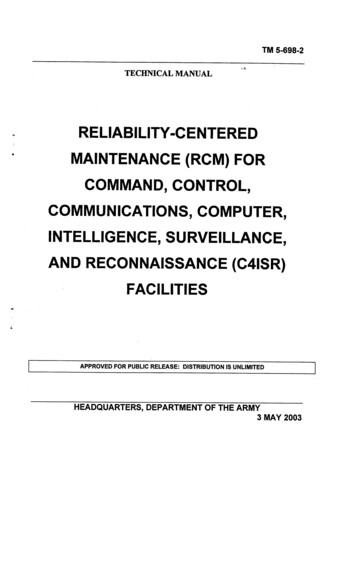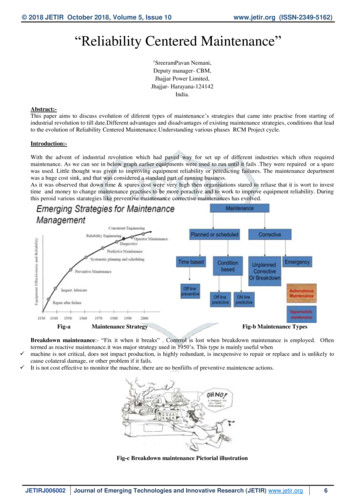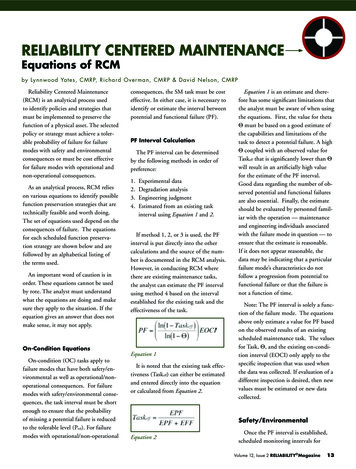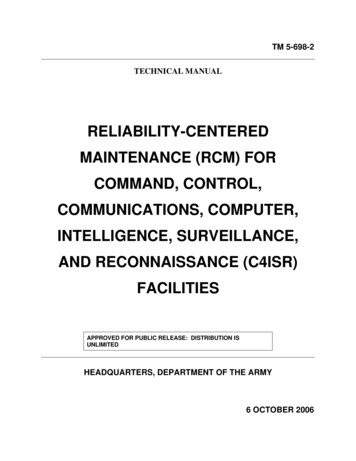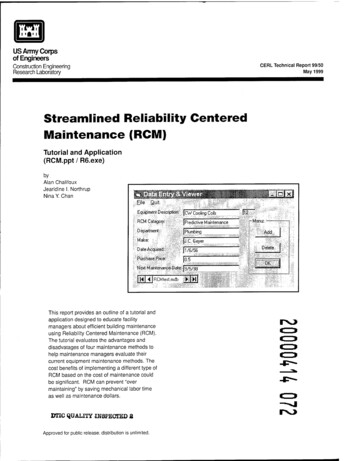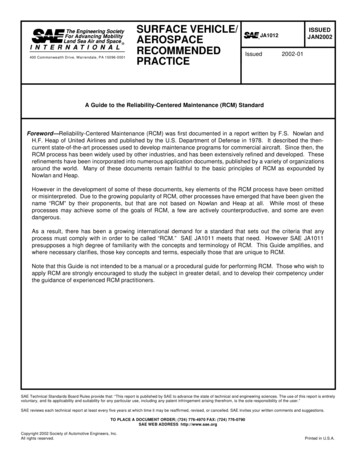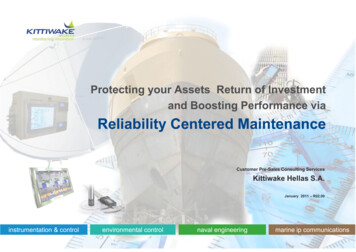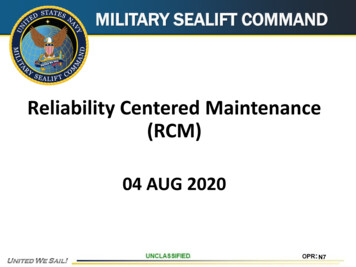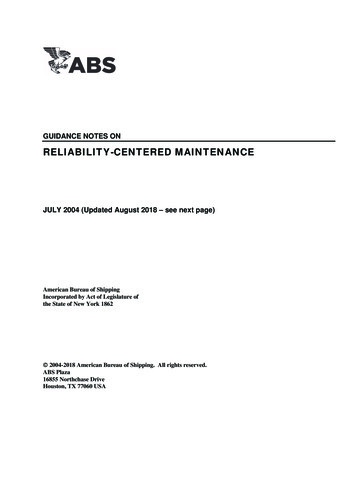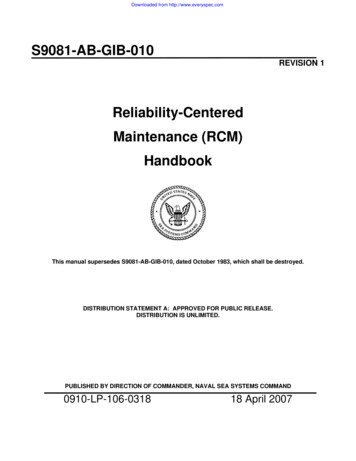
Transcription
Downloaded from http://www.everyspec.comS9081-AB-GIB-010REVISION 1Reliability-CenteredMaintenance (RCM)HandbookThis manual supersedes S9081-AB-GIB-010, dated October 1983, which shall be destroyed.DISTRIBUTION STATEMENT A: APPROVED FOR PUBLIC RELEASE.DISTRIBUTION IS UNLIMITED.PUBLISHED BY DIRECTION OF COMMANDER, NAVAL SEA SYSTEMS COMMAND0910-LP-106-031818 April 2007
Downloaded from http://www.everyspec.com
Downloaded from http://www.everyspec.com
Downloaded from http://www.everyspec.com
Downloaded from http://www.everyspec.comS9081-AB-GIB-010FORWARDIf you require assistance, contact distance support (anchor desk) viathe web http://www.anchordesk.navy.mil/) and via the toll free number(1-877-4-1-TOUCH [86824]).Ships, training activities, supply points, depots, Naval Shipyards andSupervisors of Shipbuilding are requested to arrange for the maximumpractical use and evaluation of NAVSEA technical manuals. All errors,omissions, discrepancies, and suggestions for improvement to NAVSEAtechnical manuals shall be forwarded to:COMMANDERCODE 310 TMDER, BLDG 1388NAVSURFWARCENDIV NSDSA4363 MISSILE WAYPORT HUENEME CA 93043-4307on NAVSEA Technical Manual Deficiency/Evaluation Report, form NAVSEA4160/1. All feedback comments shall be thoroughly investigated andoriginators will be advised of action resulting there from. Threecopies of NAVSEA 4160/1 are included at the end of each separatelybound technical manual 8-1/2 x 11 inches or larger. Copies of formNAVSEA 4160/1 may be downloaded DER BLANK REV 3-2001.docUsers are encouraged to transmit deficiency submittals via the NavalSystems Data Support Activity Web page located Urgent priority TM deficiencies shall be reported by Naval message toPort Hueneme Division, Naval Surface Warfare Center (Code 311), PortHueneme, CA. Local message handling procedures shall be used. Themessage shall identify each TM deficiency by TM identification numberand title.iii
Downloaded from http://www.everyspec.comS9081-AB-GIB-010—THIS PAGE INTENTIONALLY LEFT BLANK—iv
Downloaded from y-Centered Maintenance (RCM) HandbookContentsSectionTitlePage1Introduction to RCM1-11.1Purpose1-11.2History of RCM1-11.3Basis for RCM1-31.4RCM Certification1-41.5Summary1-52Fundamentals of MaintenanceEngineering (ME)2-12.1Failures Happen2-12.2Not All Failures Have the SameProbability2-22.3Not All Failures have the SameConsequences2-42.4Simple Components Wear-Out, ComplexSystems Break Down2-82.5Good maintenance provides requiredfunctionality for lowest practicable cost2-82.6Maintenance Can Only Achieve InherentDesign Reliability2-92.7Hidden Functions Require SpecialTreatment2-9v
Downloaded from y-Centered Maintenance (RCM) HandbookContentsSectionTitlePage2.8Unnecessary Maintenance TakesResources Away From NecessaryMaintenance2-102.9Good Maintenance Programs UndergoContinuous Improvement2-112.10Summary2-133What Comprises Maintenance?3-13.1Definition of Maintenance3-13.2Three Categories of Maintenance3-23.3Five Types of Preventive MaintenanceTasks3-43.4Summary3-104The Rules of RCM4-14.1Three Hypotheses4-14.2All Maintenance Tasks Must BeApplicable (Relevant)4-34.3All Maintenance Tasks Must Be Effective(Have Value)4-44.4Why We Need RCM Methodology4-54.5Summary4-55Two RCM Processes5-15.1Summary5-3vi
Downloaded from y-Centered Maintenance (RCM) HandbookContentsSectionTitlePage6The Classic RCM Process6-16.1Analyst Selection and Training6-16.2Information Collection6-26.3System Partitioning and Identification6-26.4Systems Analysis6-36.5The RCM Methodology6-36.6Designing an RCM-Based PreventiveMaintenance Program (MIL-P-24534A)6-46.7Phase 1: Functional Block Diagram andthe Master Systems and Subsystems Index(OPNAV Form 4790/114)6-56.8Phase 2: Functional Failure Analysis(OPNAV Form 4790/116)6-76.9Phase 3: Additional FunctionallySignificant Item Selection (OPNAV Form4790/117)6-86.10Phase 3 Continued: FunctionallySignificant Items Index (OPNAV Form4790/118)6-96.11Phase 4: Failure Modes and EffectsAnalysis (OPNAV Form 4790/119)6-96.12Phase 5: Decision Logic Tree Analysis(OPNAV Form 4790/120)6-106.13Phase 6: Servicing and LubricationAnalysis (OPNAV Form 4790/121)6-16vii
Downloaded from y-Centered Maintenance (RCM) HandbookContentsSectionTitlePage6.14Periodicity Considerations6-166.15Phase 7: Audit and Preparation of theMaintenance Requirement: MaintenanceRequirement Index (MR) (OPNAV Form4790/123)6-166.16Phase 8: Method Study and ProcedureEvaluation for the New Tasks and RevisedMaintenance Requirement Cards (MRCs)(OPNAV Form 4790/130)6-166.17Phase 9: Maintenance Requirement TaskDefinition (OPNAV Form 4790/124)6-176.18Phase 10: Inactive EquipmentMaintenance (OPNAV Form 4790/129)6-176.19Phase 11: Unscheduled Maintenance6-186.20Phase 12: MRC/MIP Preparation(OPNAV Forms 4790/82, 83, 84, and 85)6-186.21eRCM6-186.22Summary6-197The Backfit Process7-17.1Analyst Selection and Training7-17.2Information Collection7-17.3The Backfit RCM Methodology7-2viii
Downloaded from y-Centered Maintenance (RCM) HandbookContentsSectionTitlePage7.4Conducting a Backfit RCM Analysis of anExisting PMS Program7-27.5Finalizing PMS Task Revisions7-77.6Summary7-8Appendix AGlossaryA-1Appendix BMIL-P-24534A (NAVY) Data FormsB-1Appendix CNAVSEA/SPAWAR Technical ManualDeficiency/Evaluation Report (TMDER)C-1ix
Downloaded from http://www.everyspec.comS9081-AB-GIB-010—THIS PAGE INTENTIONALLY LEFT BLANK—x
Downloaded from http://www.everyspec.comS9081-AB-GIB-010Section 1—Introduction to RCM1.1PurposeThis handbook provides Navy maintenance practitioners a reference document for applying theprinciples of Reliability-Centered Maintenance (RCM) to the evaluation of both new and wellestablished ship planned maintenance system (PMS) preventive maintenance requirements. It isintended as a supplement to the Naval Sea Systems Command Reliability-Centered Maintenance-basedcertification program for those who develop, modify, review and authorize Planned Maintenance Systemtasks for Navy ships, systems, and equipment. The handbook introduces basic principles of maintenanceand illustrates how these principles establish rules for good maintenance tasks. It describes how theserules are used to develop maintenance requirements and associated documentation for new systems andequipment as well as to evaluate and improve the quality and effectiveness of well-establishedmaintenance programs.Requirements for analysis of preventive maintenance requirements and for development of associatedsupport documentation are defined in MIL-P-24534A, “Planned Maintenance System: development ofMaintenance Requirement Cards, Maintenance Index Pages, and Associated Documentation.”1.2History of RCMLogical methods for designing preventive maintenance programs started about a half century ago. Thisbrief history sets the stage for detailed discussion of the Reliability-Centered Maintenance methodologymandated by the Chief of Naval Operations for ship maintenance. OPNAVINST 4700.7(series)“Maintenance Policy for U.S. Navy Ships,” and OPNAVINST 4790.4(series) Ships’ Maintenance andMaterial Management (3-M) System Policy require the use of RCM for the development of maintenanceprograms and associated maintenance tasks.Efforts to look deeply into the effectiveness of preventive maintenance as a process for avoiding failurebegan in the late 1950s. Those involved in establishing preventive maintenance requirements beforethen may have been so convinced of the value of their actions that they saw no need to prove its truth.They reacted almost entirely to each event as it occurred rather than to generalize their experience.The introduction of jet aircraft fleets led the airline industry to apply a growing expertise in the processof analysis to improving the effectiveness of preventive maintenance for transport aircraft. Since theunderlying reason for preventive maintenance is the belief that reliability of hardware decreases withuse, the first efforts examined the relationship between reliability and age (use). This was done byapplication of techniques already used by life insurance actuaries.In 1967, the airline industry’s Maintenance Steering Group (MSG) first applied decision tree logic – aseries of questions that lead to a supportable maintenance task decision – to the problem of identifyingrequired preventive maintenance tasks. This predecessor of RCM proved an efficient approach, since itfocused directly on the impact of unreliability on operations and safety. The following year, decisiontree logic formed the basis for design of the initial Boeing 747 maintenance program. In the ensuing1-1
Downloaded from http://www.everyspec.comS9081-AB-GIB-010years, the airline industry updated the MSG approach and applied it to such aircraft as the Boeing 767and beyond.In the early 1970s, this work attracted the attention of the Office of the Secretary of Defense, the NavalAir Systems Command, the Air Force, and the Army. The Navy was the first to apply this newphilosophy and an improved methodology called Reliability-Centered Maintenance (RCM) to both newdesign and in-service aircraft.In 1978, United Airlines published a book prepared under contract to the Office of Assistant Secretaryof Defense (Manpower, Reserve Affairs and Logistics) detailing the RCM methodology. This book,Reliability-Centered Maintenance by Stanley Nowlan and Howard Heap and the work leading to itspublication formed the basis for the Naval Sea Systems Command application of RCM to shipmaintenance.The prototype application of RCM to surface ship preventive maintenance was installed in USSROARK (FF-1053) in 1978. Following evaluation of results on four additional FF-1052 class ships, theChief of Naval Operations directed that RCM be used for development of scheduled maintenance tasksfor all new and in-service naval ships in accordance with MIL-P-24534A, Planned Maintenance System.This application is now called “Classic RCM.”The principles of RCM were also applied to ship depot level maintenance in the Phased MaintenanceProgram (PMP) developed initially for Combat Support Ships in the early 1980s. This program, whichwas later expanded to all auxiliary ships, amphibious ships and certain combatant ships, served as thecatalyst for Continuous Maintenance (CM). CM is a nearly continuous process of identifying,screening, authorizing, planning, and accomplishing maintenance at all maintenance levels(organizational, intermediate, and depot). The underlying policy for both PMP and CM is calledCondition-Based Maintenance (CBM), which is the CNO’s policy for ship maintenance as called out inOPNAVINST 4700.7(series). CBM is defined as maintenance based on objective evidence of need.OPNAVINST 4790.16, “Condition-Based Maintenance Policy,” requires use of RCM to determineevidence needed to select appropriate maintenance.Benefits derived from the use of RCM to establish maintenance programs eroded over the years becausethe Navy tended to overlook an important part of the RCM process – periodic analysis of operationaland maintenance feedback to continuously improve the periodicity and scope of prescribed maintenancetasks. This became critical in the 1990s, when construction of new ships fell prey to the cost ofmaintaining in-service ships.Recognizing that adopting change based on operating experience is a major component and benefit ofRCM, the Naval Sea Systems Command developed an RCM methodology to be used to improveexisting preventive maintenance programs in 1996. A prototype of the so-called RCM ‘Backfit’Methodology was applied to the USS YORKTOWN (CG-48) Planned Maintenance System (PMS) aspart of the Smart Ship Program. Results included a 46.7 percent reduction in ship’s force PMSworkload without adverse impact on safety, mission, or the environment. This approach has beenrefined and is applied to all shipboard systems by Navy In-Service Engineers (ISEs) in conjunction withship’s force personnel experienced in operation and maintenance of the systems evaluated. Both theISEs and involved ship’s force personnel are provided training in Backfit RCM prior to conducting theiranalyses of existing PMS tasks during an evaluation called Ship Maintenance Effectiveness Review(SHIPMER).1-2
Downloaded from http://www.everyspec.comS9081-AB-GIB-010This handbook addresses both the ‘Classic’ RCM approach for development of new maintenancerequirements for systems and equipment and the RCM ‘Backfit’ approach for validation of maintenancerequirements for in-service systems and equipment.1.3Basis for RCMRCM is derived from careful consideration of basic questions such as the following: What functions does the system perform?What functional failures might occur?Which of the functional failures are likely to occur?Are the functional failures evident to the operating crew?What are the consequences of failure on safety, mission, and cost?What is the relative risk of failure in terms of probability of failure and severity of failure?What, if anything, can be done to prevent likely failures?What is the cost of trying to prevent failures?RCM is reliability-centered. Its objective is to maintain the inherent reliability of the system orequipment design, recognizing that changes in inherent reliability may be achieved only through designchanges. Within this constraint, RCM functions to determine what preventive maintenance is requiredto: Ensure safety of personnel, protect the environment and equipment; andProvide reasonable assurance of being able to accomplish the ship’s mission at a cost less thanthat of correcting the failure the preventive task is trying to prevent.Classic RCM develops maintenance tasks for new systems by: Partitioning the ship into systems and subsystems that require analysis;Identifying functionally significant items;Determining any needed maintenance requirements (tasks) for each significant item based onanalysis of its functions (both evident and hidden), its dominant failure modes, and managementof risk associated with functional failure;Determining when, how, and by whom each task should be accomplished; andIdentifying any need for design change:––When safety is threatened by a failure for which there is no applicable and effectivepreventive task, orWhen inherent reliability proves to be less than adequate.Backfit RCM validates existing maintenance tasks by using information from operations andmaintenance in a streamlined analysis, and adjusting task intervals and task content where appropriate.The identification and application of fundamental maintenance concepts (e.g., risk management)provides the maintenance practitioner a foundation for future application.1-3
Downloaded from http://www.everyspec.comS9081-AB-GIB-0101.4RCM CertificationThe Chief of Naval Operations (CNO) has mandated that Condition-Based Maintenance (CBM)practices be implemented in all Navy maintenance decisions involving ships, aircraft, and infrastructurein OPNAVINST 4790.16. The instruction tasks NAVSEA to “provide procedures and training for theimplementation of CBM ." The objective of condition based maintenance is that maintenance isperformed based on objective evidence of the need. Reliability Centered Maintenance (RCM) is theprocess that is used to develop the maintenance tasks needed to implement CBM. To achieve theCNO’s CBM goal, NAVSEA 04RM established the RCM Certification Program. The Naval SeaSystems Command certifies all those who develop, review, or approve scheduled maintenancerequirements to ensure that RCM principles and approved methodology are properly employed inmaintenance plan development for Organizational, Intermediate, and Depot (OI&D) levels. RCMcertification is required for all PMS practitioners in accordance with Appendix J of NAVSEAINST4790.8(series), Ship’s Maintenance and Material Management (3-M) Manual. NAVSEA 04RMmanages the RCM Certification Program and associated training.Each equipment system placed in a U.S. Navy ship has an experienced shore-based In-Service Engineer(ISE) responsible for monitoring lifecycle as well as individual problems in that system. The RCMCertification Program affects all individuals who either develop new PMS, or make changes to existingPMS. Those persons, whether they are Navy employees or contractors must achieve and maintain theappropriate level of RCM certification relevant to the work they are performing.ISEs are challenged daily with design and maintenance issues. NAVSEA’s RCM Certification Programensures that they are equipped with the skills required to develop, review or approve changes to PMS.RCM Certification comprises three certification levels.Level I - Backfit RCM for Practitioners: Level I certification is required for ISEs, CommoditySpecialists or contractors who modify existing Planned Maintenance System (PMS) maintenance tasks.The course is two days in duration and taught by an approved SEA 04RM instructor. This courseprovides training in the fundamental CBM topics and methodologies to be employed when performingan engineering review of existing PMS maintenance tasks. Upon completing certification, individualsapply this methodology to every maintenance related assessment they perform. Level I certification isvalid for three years and can be renewed by attending another Level I training class, a Ship MaintenanceEffectiveness Review (SHIPMER) session, or by satisfactorily completing an online recertificationexamination.Level II – Classic RCM for PMS Requirement Developers: Level II certification applies to ISEs,Commodity Specialists or contractors who develop or approve maintenance requirements for newsystems or equipment. The course begins with an introduction to maintenance engineering and RCMfundamentals and leads to detailed instruction in the MIL-P-24534A (Navy) process for developingmaintenance task requirements for Navy equipment. The student is guided through multiple practical1-4
Downloaded from n examples to further illustrate the RCM process and to prepare for the certificationexamination. The course is five days in duration and taught by an approved NAVSEA 04RM instructor.Level II certification is valid for three years and can be renewed by attending another Level II trainingclass or by satisfactorily completing an online recertification examination.Level III – Navy Backfit RCM Trainer: Level III certification applies to a very small number of ISEswho have been selected to teach the Level I certification course within their command or activity.Individuals selected for Level III training must be certified in both Level I and Level II and demonstratea high level of proficiency in RCM as outlined in MIL-P-24534A (Navy). The Level III course iscomposed of two major elements and is two weeks in duration. The first week is devoted to an intensivereview of RCM theory and application including a comprehensive examination of RCM fundamentalsand instructor oriented training in the RCM Level I curriculum. The second week is an introductorycourse on adult training techniques and includes opportunity to practice the presentation of the RCMLevel I course material in a controlled environment. Level III certification requires the demonstration ofinstruction proficiency of the RCM Level I course material and is valid for one year. Renewal ofcertification is contingent upon successful demonstration of continued proficiency to NAVSEA 04RMor designated technical warrant holder.1.5SummaryIn 1967 the airline industry’s Maintenance Steering Group (MSG) applied the first decision logic treefor development of preventive maintenance. This work grew out of a comprehensive review ofmaintenance practices begun in the late 1950s. By the 1970s, a systematic approach for thedevelopment of maintenance had become known as “Reliability-Centered Maintenance” (RCM). Thefundamental goals of RCM were to maintain system functionality by ensuring all maintenance actionswere designed to maximize system reliability at minimum cost. To accomplish this, the RCM process isa structured approach that requires the analyst to justify maintenance requirements by answering a seriesof questions. What functions does the system perform?What functional failures might occur?Which of the functional failures are likely to occur?Are the functional failures evident to the operating crew?What are the consequences of failure on safety, mission, and cost?What is the relative risk of failure in terms of probability of failure and severity of failure?What, if anything, can be done to prevent likely failures?What is the cost of trying to prevent failures?The US Navy began applying RCM to surface ship maintenance in 1978. Within a few decades RCMhas become a fundamental part of the Navy’s Conditioned Based Maintenance (CBM) Policy. Toensure RCM principles are understood and applied across all maintenance decisions during a ship’sentire life cycle, Naval Sea Systems Command has instituted a certification program. All personnelassociated with the development, review, or approval of scheduled maintenance requirements arerequired to undergo training in RCM fundamentals as they apply to existing maintenance (Level I) ornew maintenance (Level II).1-5
Downloaded from http://www.everyspec.comS9081-AB-GIB-010—THIS PAGE INTENTIONALLY LEFT BLANK—1-6
Downloaded from http://www.everyspec.comS9081-AB-GIB-010Section 2―Fundamentals of Maintenance Engineering (ME)This section briefly explains nine fundamental maintenance concepts that govern the development,implementation, execution, and continuous improvement of ship maintenance programs. These are coreprinciples of RCM. These nine fundamental concepts are: Failures happen.Not all failures have the same probabilityNot all failures have the same consequencesSimple components wear out, complex systems break downGood maintenance provides required functionality for lowest practicable costMaintenance can only achieve inherent design reliabilityHidden functions require special treatmentUnnecessary maintenance takes resources away from necessary maintenanceGood maintenance programs undergo continuous improvement.These concepts form a progression of maintenance engineering thought from the most fundamentalconcept failures happen to the greatest challenge for any maintenance program: establishment of aprocess for continuous improvement.2.1Failures HappenIt is appropriate to begin discussion with the fact that functional failures -- unsatisfactory conditions inwhich intended functions are not adequately provided -- happen.Maintenance planners know intuitively, if not by personal experience, that unexpected failures happen.Nevertheless, they tend to approach the business of maintenance program planning from one of two verydifferent directions. One direction is to attempt to eliminate all failures. The second direction is riskmanagement. There are many factors in equipment reliability that can cause a failure. They includestress, corrosion and fatigue. A maintenance program can be used to prevent or preclude such failures.However, there are failures caused by things beyond the control of the maintainer. These includeunplanned or random events (sudden high-energy impact, lightning strike, etc.), sometimes called acts ofGod. There is nothing that can be done to prevent these failures, especially from an economicstandpoint. There are failures caused by poor manufacturing quality. These types of failures cannot beprevented by maintenance.We know that not all failures can be prevented. Good maintenance programs don’t try to prevent allfailures; they couldn’t if they tried! Good maintenance programs will minimize the number of failures,however, perhaps even to the point where they appear to have been totally eliminated.The paradigm of attempting to prevent all failures has lead to extremely costly maintenance programsthat do not succeed because all failures cannot be prevented. The important thing is to focus resourceson failures that can be prevented.2-1
Downloaded from http://www.everyspec.comS9081-AB-GIB-0102.2Not All Failures Have the Same ProbabilityReliability engineers define reliability as the probability that equipment will provide its desired functionover a specified period of time. When maintainers speak of probability of failure, they really mean therate at which a piece of equipment will fail over a period of time, i.e. the frequency, or rate, of failure.Things to consider about probability of failure are: Is that probability, or rate, of failure a function oftime? Is it increasing in frequency? (a bad thing), Is it decreasing in frequency? (a good thing), or is itconstant. A constant failure rate is often called random failures. It is often said that complex equipmentexperiences random failures. So how do real-world equipment failure rates compare to our preconceivednotions about probability of failure?The pioneering work on Reliability-Centered Maintenance performed by United Airlines began with astudy of hardware age-reliability characteristics. When United disassembled engines for repair, it foundsome engines whose internal components were in good condition and some engines whose internalcomponents were in poor condition. Further, when United began to explore the age-reliabilityrelationship by introducing these engines back into service after minimal repair, it found that someengines with internal components in good condition exhibited lower reliability in service than engineswith components in worn condition. United realized that it did not have as firm a grip on therelationship between time in service (or “age”) and reliability as it thought. Reliability degradation is areduction of an item’s resistance to failure.United Airlines applied the same technique used by insurance actuaries when developing mortalitycurves for human beings. This technique was used to explore the relationship between the failure-rate orconditional probability of failure and some measure of operating age for aircraft hardware. Theconditional probability of failure is the failure rate of the component with respect to time. A constantconditional probability of failure means that the failure rate is not increasing or decreasing with respectto time, it means that we have random failures.The results of United’s initial exploration of this relationship are shown in Figure 2.1 in column markedUAL, which were developed from a study of 139 aircraft components and equipment. These resultsshow both wear out (age-related failures, curves A, B, and C) and random failures (curves D, E, and F).The figure also includes similar results from later studies.2-2
Downloaded from 3MSDP ndomAge-RelatedPfUALEvidence ofWearoutNoEvidenceof Wearout(Figure 2.1.) Age-Reliability Characteristics Curves.Analysis showed that:1. Random failures predominate compared to age-related failures. Infant mortality (i.e., high initialprobability of failure, decreasing with age) is common.2. Infant mortality persists (significant time is required to transition out of infant mortality to steadystate conditional probability of failure).3. The conditional probability of failure is never zero.4. The shape of the age-reliability characteristic curve is highly configuration-dependent.5. Simple items tend to exhibit wear out (curves A, B and C) whereas complex items tend to exhibitrandom failures (curves D, E and F).Curves D, E, and F should not be interpreted to mean that some items never degrade or wear out. Thesecurves simply show the life of some items came to an end before wear out was evident, perhaps becausethey were removed for restoration, or were replaced with modified or upgraded items. Everything willeventually degrade with time, but some items degrade so slowly that wear out is not a concern since thedegradation will not adversely affect performance during the life of the ship. Degradation of the glass inthe bridge windows, for example, does not trouble the maintenance planner, who needs to focus onitems whose degradation is of real concern.Age-reliability characteristics curves can tell a maintenance planner whether or not wear out (increase inthe conditional probability of failure) exists. If there is no evidence of wear out, there2-3
Downloaded from http://www.everyspec.comS9081-AB-GIB-010is no good basis for a time-directed life-renewal task. It makes no sense to spend maintenance resourcesto renew the life of an item whose reliability has not degraded or which may have actually improvedwith age.It is not necessary to develop age-reliability characteristics curves for every item of equipment. In fact,these curves should be limited to a small set of high-value items where the investment cost of curvedevelopment will be returned in reduced life-cycle maintenance requirements. Maintenance plannersneed to keep these curves and the lessons they teach in mind as they review maintenance for theitems for which they are responsible.Rapid increase in the conditional probability of failure of an item may be associated with a component,subassembly, or assembly within an item or it may be typical of the complete item. The morecomplex an item, the less likely it is that all its constituent elements will have the same age-to-failurecharacteristics.2.3Not All Failures have the Same ConsequencesMaintenance is an investment, an indirect cost that organizations are willing to bear with the expectationthey will receive a benefit in the form of sustained perso
Reliability-Centered Maintenance by Stanley Nowlan and Howard Heap and the work leading to its publication formed the basis for the Naval Sea Systems Command application of RCM to ship maintenance. The prototype application of RCM to
